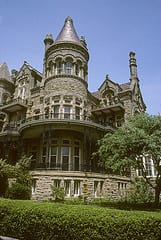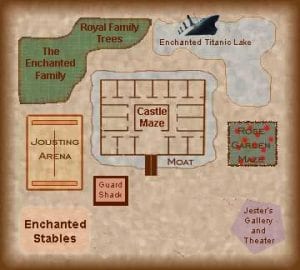 An indispensible feature of the castle of a great lord was the chapel where the lord and his family heard morning mass. In rectangular hall-keeps this was often in the forebuilding, sometimes at basement level, sometimes on the second floor. By the 13th century, the chapel was usually close to the hall, convenient to the high table and bed chamber, forming an L with the main building or sometimes projecting opposite the chamber. A popular arrangement was to build the chapel two stories high, with the nave divided horizontally; the family sat in the upper part, reached from their chamber, while the servants occupied the lower part.
An indispensible feature of the castle of a great lord was the chapel where the lord and his family heard morning mass. In rectangular hall-keeps this was often in the forebuilding, sometimes at basement level, sometimes on the second floor. By the 13th century, the chapel was usually close to the hall, convenient to the high table and bed chamber, forming an L with the main building or sometimes projecting opposite the chamber. A popular arrangement was to build the chapel two stories high, with the nave divided horizontally; the family sat in the upper part, reached from their chamber, while the servants occupied the lower part.
The living quarters of a castle invariably had one basic element is the hall. Castle halls can be on the moot, in the bailey, inside the walls of the shell keep, or as a separate building within the great curtain walls of the 13th century. A large one-room structure with a loft ceiling, the hall was sometimes on the ground floor, but often it was raised to the second story for greater security. Early halls were aisled like a church, with rows of wooden posts or stone pillars supporting the timber roof. Windows were equipped with wooden shutters secured by an iron bar, but in the 11th and 12th centuries were rarely glazed. By the 13th century they might have white glass in some windows, and by the 14th century glazed windows were common.
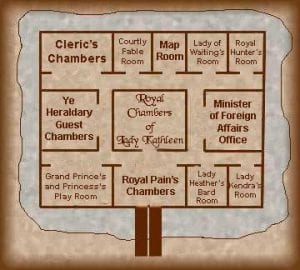 In a ground-floor hall the floor was beaten earth, stone or plaster; when the hall was elevated to the upper story the floor was nearly always timber, supported either by a row of wooden pillars in the basement below or by stone vaulting. Carpets, although used on walls, tables, and benches, were not used as floor coverings in Britain and northwest Europe until the 14th century. Floors were strewn with rushes and in the later Middle Ages sometimes with herbs. The rushes were replaced at intervals and the floor swept, but don’t ask about what might be underneath.
In a ground-floor hall the floor was beaten earth, stone or plaster; when the hall was elevated to the upper story the floor was nearly always timber, supported either by a row of wooden pillars in the basement below or by stone vaulting. Carpets, although used on walls, tables, and benches, were not used as floor coverings in Britain and northwest Europe until the 14th century. Floors were strewn with rushes and in the later Middle Ages sometimes with herbs. The rushes were replaced at intervals and the floor swept, but don’t ask about what might be underneath.
Entrance to the hall was usually in a side wall near the lower end. When the hall was on an upper story, this entrance was commonly reached by an outside staircase next to the wall of the keep. The castle family sat on a raised dais of stone or wood at the upper end of the hall, opposite to the entrance, away from drafts and intrusion. The lord and lady occupied a massive chair, sometimes with a canopy by way of emphasizing status. Everyone else sat on benches. Most dining tables were set on temporary trestles that were dismantled between meals. But all tables were covered with white cloths, clean and ample. Lighting was by rushlights or candles, of wax or tallow, normally impaled on vertical spikes or an iron candlestick with a tripod base, or held in a loop, or supported on wall brackets or iron candelabra. Oil lamps in bowl form on a stand, or suspended in a ring, provided better illumination, and flares sometimes hung from iron rings in the wall.
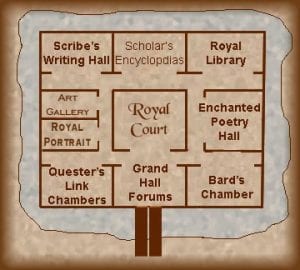 In the later Middle Ages things only were slight improved in lighting over earlier centuries, a major technical advance had come in heating: the fireplace, an invention of deceptive simplicity. The fireplace provided heat both directly and by radiation from the stones at the back, from the hearth, and finally, from the opposite wall, which was given extra thickness to absorb the heat and warm the room after the fire had burned low. Square, circular, or octagonal, the central hearth was bordered by stone or tile and sometimes had a backing of tile, brick or stone. Smoke rose through a louver, a lantern-like structure in the roof with side openings that were covered with sloping boards to exclude rain and snow, and that could be closed by pulling strings, like venetian blinds. There were also roof ventilators. A fire cover made of tile or china was placed over the hearth at night to reduce the fire hazard.
In the later Middle Ages things only were slight improved in lighting over earlier centuries, a major technical advance had come in heating: the fireplace, an invention of deceptive simplicity. The fireplace provided heat both directly and by radiation from the stones at the back, from the hearth, and finally, from the opposite wall, which was given extra thickness to absorb the heat and warm the room after the fire had burned low. Square, circular, or octagonal, the central hearth was bordered by stone or tile and sometimes had a backing of tile, brick or stone. Smoke rose through a louver, a lantern-like structure in the roof with side openings that were covered with sloping boards to exclude rain and snow, and that could be closed by pulling strings, like venetian blinds. There were also roof ventilators. A fire cover made of tile or china was placed over the hearth at night to reduce the fire hazard.
When the hall was raised to the second story, a fireplace in one wall took the place of the central hearth, dangerous on an upper level, especially with a timber floor. The hearth was moved to a location against a wall with a funnel or hood to collect and control the smoke, and finally, funnel and all, was incorporated into the wall. This early type of fireplace was arched, and set into the wall at a point where it was thickened by an external buttress, with the smoke venting through the buttress. Toward the end of the 12th century, the fireplace began to be protected by a projecting hood of stone or plaster which controlled the smoke more effectively and allowed for a shallower recess. Flues ascended vertically through the walls to a chimney, cylindrical with an open top, or with side vents and a conical cap.
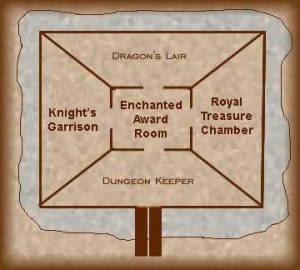 In the 13th century the castle kitchen was still generally of timber, with a central hearth or several fireplaces where meat could be spitted or stewed in a cauldron. Utensils were washed in a scullery outside. Poultry and animals for slaughter were trussed and tethered nearby. Temporary extra kitchens were set up for feasts. In the bailey near the kitchen the castle garden was usually planted with fruit trees and vines at one end, and plots of herbs, and flowers – roses, lilies, heliotropes, violets, poppies, daffodils, iris, gladiola. There might also be a fishpond, stocked with trout and pike.
In the 13th century the castle kitchen was still generally of timber, with a central hearth or several fireplaces where meat could be spitted or stewed in a cauldron. Utensils were washed in a scullery outside. Poultry and animals for slaughter were trussed and tethered nearby. Temporary extra kitchens were set up for feasts. In the bailey near the kitchen the castle garden was usually planted with fruit trees and vines at one end, and plots of herbs, and flowers – roses, lilies, heliotropes, violets, poppies, daffodils, iris, gladiola. There might also be a fishpond, stocked with trout and pike.
In the earliest castles the family slept at the extreme upper end of the hall, beyond the dais, from which the sleeping quarters were typically separated by only a curtain or screen. Sometimes castles with ground-floor halls had their great chamber, where the lord and lady slept, in a separate wing at the dais end of the hall, over a storeroom, matched at the other end, over the buttery and pantry, by a chamber for the eldest son and his family, for guests, or for the castle steward. These second-floor chambers were sometimes equipped with peepholes concealed in wall decorations by which the owner or steward could keep an eye on what went on below.
The lord and lady’s chamber, normally situated on an upper floor and its principal item of furniture was a great bed with a heavy wooden frame and springs made of interlaced ropes or strips of leather, overlaid with a feather mattress, sheets, quilts, fur coverlets, and pillows. Such beds could be dismantled and taken along on the frequent trips a great lord made to his castles and other manors. The bed was curtained, with linen hangings that pulled back in the daytime and closed at night to give privacy as well as protection from drafts. Personal servants might sleep in the lord’s chamber on a pallet or trundle bed, or on a bench. Chests for garments, a few “perches” or wooden pegs for clothes, and a stool or two made up the remainder of the furnishings. Sometimes a small anteroom called the wardrobe adjoined the chamber – a storeroom where cloth, jewels, spices and plates were stored in chests, and where dressmaking was done.
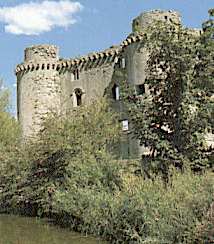 In the early Middle Ages, when few castles had large permanent garrisons, not only servants but military and administrative personnel slept in towers or in basements, or in the hall, or in lean-to structures; knights performing castle guard slept near their assigned posts. Later, when castles were manned by larger garrisons, often mercenaries, separate barracks, mess halls, and kitchens were built.
In the early Middle Ages, when few castles had large permanent garrisons, not only servants but military and administrative personnel slept in towers or in basements, or in the hall, or in lean-to structures; knights performing castle guard slept near their assigned posts. Later, when castles were manned by larger garrisons, often mercenaries, separate barracks, mess halls, and kitchens were built.
Except for the screens and kitchen passages, the domestic quarters of medieval castles contained no internal corridors in early medieval castles. Rooms opened into each other, or were joined by spiral staircases which required minimal space and could serve pairs of rooms on several floors. Covered external passageways joined a chamber to a chapel or to a wardrobe and might have windows, paneling, and even fireplaces.
Water for washing and drinking was often available at a central drawing point on each floor. Besides the well, inside or near the keep, there might be a cistern or reservoir on an upper level whose pipes carried water to the floors below. Hand washing was sometimes done at a laver or built-in basin in a recess in the hall entrance, with a projecting trough. Servants filled the tank above, and waste water was carried away by a lead pipe below, inflow and outflow controlled by valves with bronze or copper taps and spouts. Baths were taken in a wooden tub, protected by a tent or canopy and padded with cloth. In warm weather, the tub was often placed in the garden; in cold weather, in the chamber near the fire. When the lord travelled, the tub accompanied him, along with a bathman who prepared the baths. The latrine was situated as close to the bed chamber as possible (nd was supplemented by the universally used chamber pot. Ideally, the latrine was sited at the end of a short, right-angled passage in the thickness of the wall, often a buttress. When the chamber walls were not thick enough for this arrangement, a latrine was carved out from the wall over either a moat or river.
